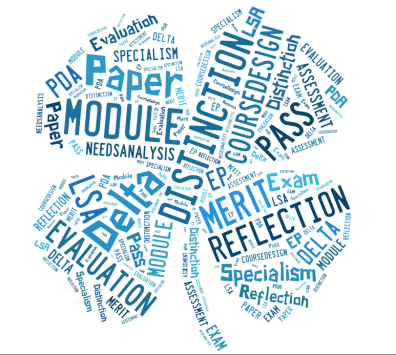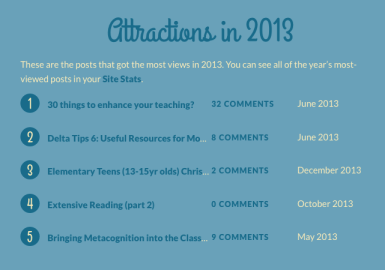To quote from the official Cambridge assessment website, The Delta (Diploma of English Language Teaching to Speakers of Other Languages) is:
“one of the best-known and most popular advanced TEFL/TESOL qualifications in the world. It is a flexible way for experienced English language teachers to progress further in their careers. Delta can be taken at any stage in a teacher’s career and is ideal for those wanting to update their teaching knowledge and improve their practice.”
It is a modular exam, consisting of three modules:
-
Module 1:
Understanding language, methodology and resources for teaching. (Assessment: An exam consisting of two 1.5hr papers done in sequence with a break in between)
-
Module 2:
Developing Professional Practice (Assessment: Three pieces of internal course work comprising a background essay, a lesson plan, an assessed lesson based on that plan and a reflection, followed by another piece of coursework with the same components but all assessed by a Delta Examiner)
-
Module 3:
Extending Practice and English Language Teaching specialism (Assessment: An extended written assignment of 4500 words based on your specialism) There is also an English Language Management option.
This post guides you through the processes of:
 1. choosing how and where to do your course
1. choosing how and where to do your course
 2. preparing for your course
2. preparing for your course
 3. completing each of the modules
3. completing each of the modules
 4. moving on to greater things ( 🙂 )
4. moving on to greater things ( 🙂 )
Based on my experience of the Delta, and incorporating the experience of others, it is structured as a Q and A, dealing with questions you might have with regards to each of the above categories as you progress through them and contains links to many handy resources (all easily identifiable with this symbol ![]() ) – some of which are mine, some of which are not. I hope it proves a useful resource to refer back to as the questions arise!
) – some of which are mine, some of which are not. I hope it proves a useful resource to refer back to as the questions arise!
1. Choosing how and where to do your course
If you are thinking about doing the Delta, it is important to be aware of the options available to you. There are many options for how to complete these modules:
- intensively (all three modules in one go)
- part-time (one module at a time, or two modules at a time, in sequence or spaced out)
- distance learning or face-to-face.
Q. How can I find out which way would best suit me?
A. The best thing to do is find out as much as you can about the various options before you make your decision:
 Sandy Millin has created “Delta Conversations”, a series of guest posts in which people have answered questions about the Delta they did. This would be a good starting point to help you understand the pros and cons of each option. (And when you’ve finished your Delta, contact her to participate!)
Sandy Millin has created “Delta Conversations”, a series of guest posts in which people have answered questions about the Delta they did. This would be a good starting point to help you understand the pros and cons of each option. (And when you’ve finished your Delta, contact her to participate!)
 (I took part in the above-mentioned series, and you can find out more about my experience of doing the Delta intensively at Leeds Metropolitan University here.)
(I took part in the above-mentioned series, and you can find out more about my experience of doing the Delta intensively at Leeds Metropolitan University here.)
 TEFL.net have a nice, short FAQ page about the Delta, which also has a link to another page with FAQs about higher qualifications in general.
TEFL.net have a nice, short FAQ page about the Delta, which also has a link to another page with FAQs about higher qualifications in general.
Once you have decided which route to take, you can really help yourself by doing some preparation before you start your course: both in terms of the course content and your own well-being.
I would say in my case that all the preparation I did in the run up to the course was one of the major factors in my success with it (the other major factor being my tutors and course mates at Leeds Met! 🙂 )
2. Preparing for your Delta: possible pre-course questions and where to find the answers:
Q. What should I do before I start my Delta?
A. There are a few things you can do, before embarking on this extraordinary journey, to help yourself begin on firm footing.
 Firstly, look at Cambridge’s How to prepare for the Delta link.
Firstly, look at Cambridge’s How to prepare for the Delta link.
 You could also think about investing in the latest book to hit The Round’s virtual bookshelves: How to Pass Delta : by the extremely experienced Damian Willians, it is available for a small fee and, I imagine, well worth that investment!
You could also think about investing in the latest book to hit The Round’s virtual bookshelves: How to Pass Delta : by the extremely experienced Damian Willians, it is available for a small fee and, I imagine, well worth that investment!
If you are still slightly bemused, or just thirsty to read more, here are several blogposts you could look at next, each of which contains guidance related to this question…
 Before, during and after the Delta: I wrote this post, based on my experience of doing the Delta. It contains tips to help you stay sane pre-, during- and post-Delta experience.
Before, during and after the Delta: I wrote this post, based on my experience of doing the Delta. It contains tips to help you stay sane pre-, during- and post-Delta experience.
 Delta FAQ: In this post, I answered students’ questions about the Delta on their induction day at Leeds Met. It contains lots of tips for preparing yourself for the Delta and making the most of it while you are doing it, including a list of things that are useful to know before you start and as you set off on mission Delta. It also contains a couple of reading recommendations for each of the systems (grammar, phonology, discourse, lexis) and skills (reading, writing, speaking and listening)
Delta FAQ: In this post, I answered students’ questions about the Delta on their induction day at Leeds Met. It contains lots of tips for preparing yourself for the Delta and making the most of it while you are doing it, including a list of things that are useful to know before you start and as you set off on mission Delta. It also contains a couple of reading recommendations for each of the systems (grammar, phonology, discourse, lexis) and skills (reading, writing, speaking and listening)
 Preparing for the Delta: Sandy provides her top tips for preparing to do your Delta. Well worth a read.
Preparing for the Delta: Sandy provides her top tips for preparing to do your Delta. Well worth a read.
Q. That list of books from Cambridge is massive, I don’t know where to start – what should I read first?
A. It *is* a massive list: there’s a lot of amazing ELT-related literature out there! However, if you want something a bit smaller and more manageable to start off with, I have created an annotated list of potentially useful resources:
 Annotated List of Resources I found useful in preparing for and doing the Delta: Does what it says on the tin – getting to grips with some of this will help lighten the load during the course. (It will still be ridiculously heavy but your sanity may stay closer to intact!) Getting ahead with reading will mean that you have more time (and processing space in your brain!) to devote to grappling with pernickety Cambridge requirements. This post is broken down by module, and then in module 2 by LSA and then PDA.)
Annotated List of Resources I found useful in preparing for and doing the Delta: Does what it says on the tin – getting to grips with some of this will help lighten the load during the course. (It will still be ridiculously heavy but your sanity may stay closer to intact!) Getting ahead with reading will mean that you have more time (and processing space in your brain!) to devote to grappling with pernickety Cambridge requirements. This post is broken down by module, and then in module 2 by LSA and then PDA.)
3. During your Delta
When you start doing your Delta, there will be huge amounts of information coming your way. You will probably also discover just how tricky it is to jump through hoops whose size and whereabouts you aren’t entirely sure of. (The good news is, you can learn a lot too, and really enrich your practice!)
As you work your way through your Delta modules, questions about what to do and how to do it may crop up. Here are some potential questions that may arise and some resources to help you answer them:
Module 1
Q. How DOES the exam fit together?
A. Here is a flow-chart that shows the structure of the exam, complete with suggested timings for each question:
 Delta Module 1 Exam: A very handy visual to start with.
Delta Module 1 Exam: A very handy visual to start with.
Q. I’ve looked at the Delta handbook and tried to understand just what it is the examiners want, and I listen really carefully in my preparation classes, but I still don’t really get it. How do I answer the questions the way they want me to?
A. Here are some blog posts related to the structure of the two exam papers, with tips for how to answer each question successfully and package your answers the Cambridge way…
 Delta Tips 4: Delta exam paper 1 – tips related to the structure of this part of the exam in terms of what each question requires and the points available, as well as how to approach answering the questions, in terms of laying out the information in an examiner-friendly way.
Delta Tips 4: Delta exam paper 1 – tips related to the structure of this part of the exam in terms of what each question requires and the points available, as well as how to approach answering the questions, in terms of laying out the information in an examiner-friendly way.
 Delta Tips 5: Delta exam paper 2 – as above but for paper 2.
Delta Tips 5: Delta exam paper 2 – as above but for paper 2.
 Paper One Dale Coulter’s guide to part 1 of the exam, also dealing with structure and answering the questions.
Paper One Dale Coulter’s guide to part 1 of the exam, also dealing with structure and answering the questions.
 Paper Two : As above, but for Paper 2.
Paper Two : As above, but for Paper 2.
Q. The exam date is getting nearer, and I really don’t feel ready! How can I help myself revise more effectively?
A. There are many ways of going about module one revision – reading, doing past papers (have you done all of these, on the Cambridge website?), boning up on terminology, language analysis, or how to write in phonemic script… Here are some links to help your revision along:
 Delta Tips 6: Useful resources for Module 1 revision – a collection of links that will be useful as the exam approaches.
Delta Tips 6: Useful resources for Module 1 revision – a collection of links that will be useful as the exam approaches.
 Revision chart: A colourful revision chart that I made for the Module 1 exam, this provides a visual aid to help with remembering the structure of the exam and how to lay out your answers.
Revision chart: A colourful revision chart that I made for the Module 1 exam, this provides a visual aid to help with remembering the structure of the exam and how to lay out your answers.
 Delta Tips 15: A checklist for anybody preparing for the Module 1 exam
Delta Tips 15: A checklist for anybody preparing for the Module 1 exam
 Sandy’s preparation tips: How Sandy prepared for Module 1.
Sandy’s preparation tips: How Sandy prepared for Module 1.
Q. You said I should use Quizlet to revise terminology, but I don’t know how?!
A. You can find out how to use it, through the following step-by-step guide:
 Quizlet!. (NB this was created for language learners, but the principle is the same – only the content of your cards will differ! 🙂 )
Quizlet!. (NB this was created for language learners, but the principle is the same – only the content of your cards will differ! 🙂 )
Once you understand it better, you could do worse than check out Sandy Millin’s Delta Group on it…
Q. I have no life! I haven’t since I started this damn course. Is this normal?
A. Don’t worry, you aren’t alone!
 Barry O’Leary shares his journey here.
Barry O’Leary shares his journey here.
But do try and take some time for yourself, however hard it is to make:
 Before, during and after the Delta: has some tips for holding on to your sanity mid-Delta, which can be found in the middle part of this post.
Before, during and after the Delta: has some tips for holding on to your sanity mid-Delta, which can be found in the middle part of this post.
Module 2
Q. I have to write an LSA essay. Hmm. How do I do that?
A. First you need to decide which system (grammar, lexis, phonology, discourse) or skill (receptive: listening or reading; productive: speaking or writing) to focus on, which at least initially will probably be influenced by your centre and the running order of their module 2 course.
When you embark on the essay, your tutors will be best placed to guide you in the “how”, but for some additional tips, have a look at:
 Delta Tips 1 : Writing a background essay for an LSA, which provides some suggestions for getting to grips with this beast.
Delta Tips 1 : Writing a background essay for an LSA, which provides some suggestions for getting to grips with this beast.
You may also find it useful to look at
 my Delta Notes series (based on notes I made during my Delta, so far including error correction and teaching listening, with more forthcoming)
my Delta Notes series (based on notes I made during my Delta, so far including error correction and teaching listening, with more forthcoming) Sandy Millin’s carefully-tagged Delta-related bookmarks may be useful!
Sandy Millin’s carefully-tagged Delta-related bookmarks may be useful!
Q. Right, I’ve finished my essay, how about the lesson plan? There seem to be endless criteria to fulfil…
A. Yes, there are lots of criteria – hopefully you’ve left plenty of time to get to grips with this component. In addition to listening very carefully to your tutors’ suggestions, you could have a look at my blog post with some tips for how to help yourself meet these:
 Delta Tips 2: (my tips for) writing an LSA lesson plan
Delta Tips 2: (my tips for) writing an LSA lesson plan
Q. I’ve survived the lesson (thank God!) but now I need to do the post-lesson evaluation. Where do I start? What should I include?
A. As well as reading the Delta Handbook on this topic, and following your tutors’ advice, for some extra tips you could look at my post on the topic:
 Delta Tips 3: (My tips for) Writing an LSA post-lesson reflection/evaluation
Delta Tips 3: (My tips for) Writing an LSA post-lesson reflection/evaluation
Q. This module is driving me crazy!! I think I’m going to cry…
A. Again, you are not alone:
 This post, by Tefalump, The stages of a Delta assignment, should be somewhat comforting – it’s normal for Module 2 to make you cry at some point(s)!
This post, by Tefalump, The stages of a Delta assignment, should be somewhat comforting – it’s normal for Module 2 to make you cry at some point(s)!
 My post The Delta/M.A. Treadmill echoes the “arrrrghhh” (mixed in with exhilaration!) and offers some tips for sanity maintenance! (Not a serious post… 😉 )
My post The Delta/M.A. Treadmill echoes the “arrrrghhh” (mixed in with exhilaration!) and offers some tips for sanity maintenance! (Not a serious post… 😉 )
Q. I still have to do my PDA part A and Experimental Practice. Can’t I just leave them until I’ve sorted out the LSAs?
A. It would be much better to get started as soon as possible! The PDA part A is supposed to be done alongside your module 2 work, as it is your opportunity to develop into a reflective practitioner. What you learn while doing your PDA could/should feed directly into your development in your LSA lesson planning and teaching practices. Equally, any weaknesses highlighted in your LSAs could/should feed into your PDA. I found this component of Module 2 very valuable developmentally and would really recommend not putting it on the back burner.
 Delta Tips 7: Doing PDA Part A offers some tips for getting the most out of your PDA.
Delta Tips 7: Doing PDA Part A offers some tips for getting the most out of your PDA.
The Experimental Practice is another valuable learning opportunity: it actually helped me figure out what to do with my PDA (I was slow to catch on!), and, long term, how to embark on a cycle of reflection, experimentation, evaluation and more reflection.
 Delta Tips 8: Doing the Experimental Practice offers some tips for getting the most out of your EP.
Delta Tips 8: Doing the Experimental Practice offers some tips for getting the most out of your EP.
 Experimental Practice in ELT by Jennie Wright and Christina Rebuffet-Broadus is available from The Round for a small fee, containing ideas and sample lesson plans suited to the EP as well as to teachers who want to Experiment outside of Delta training.
Experimental Practice in ELT by Jennie Wright and Christina Rebuffet-Broadus is available from The Round for a small fee, containing ideas and sample lesson plans suited to the EP as well as to teachers who want to Experiment outside of Delta training.
Module 3
Q. Cambridge wants me to do WHAT? I’m confused… Where should I start? What do they want? What should I read?
A. I would start by reading the Module 3 section of the handbook! If you are still no clearer, you could have a look at:
 Delta Tips 9: Writing a Module 3 Essay – Overview and Starting Out
Delta Tips 9: Writing a Module 3 Essay – Overview and Starting Out
Hopefully the input sessions on your course will also help you understand what you are supposed to produce, how and when.
Q. I’m writing a draft of my introduction now, but I’m not entirely sure if I’m doing it right. How do I fit in everything that Cambridge seem to want?
A. Well, you’re off to a good start if you know what Cambridge want! 🙂
 Delta Tips 10: in Writing a Module 3 Essay – the Introduction I offer some tips for how to meet Cambridge’s criteria for the introduction. It might also help if you are still a little hazy about exactly what to include in your introduction.
Delta Tips 10: in Writing a Module 3 Essay – the Introduction I offer some tips for how to meet Cambridge’s criteria for the introduction. It might also help if you are still a little hazy about exactly what to include in your introduction.
Q. How do I do a Needs Analysis with my students and what should I write in the corresponding essay section?
A. The Needs Analysis is an important element of the extended assignment. This is where you take the issues that you pinpointed in your introduction, consider how to assess your learners in order to identify where they stand in relation to these, and identify the areas that your course design will need to focus on. If you put a lot of reading, effort and thought into this section and create your tools very carefully, you will make your life a lot easier in the subsequent sections.
Here are some tips and recommended reading (books, articles etc) that I put together for working your way through this section of the essay:
 Delta Tips 11: Writing a Module 3 Essay – the Needs Analysis
Delta Tips 11: Writing a Module 3 Essay – the Needs Analysis
Q. Well, I’m not sure if my Needs Analysis is quite right, but nevertheless it’s time to design and write about my course. How do I get from the priorities that my NA highlighted to my completed course plan and course design section? (Ideally without going insane in the process…)
A. This is arguably the most time-consuming portion of the extended assignment: You need to produce a 20hr course plan that addresses the priorities you’ve identified, and write about it in such a way that covers everything that Cambridge want to know about it. You may also want to showcase some sample materials that your course uses in your appendices.
Here are some tips and recommended reading that I put together to help you get through this section of the essay:
 Delta Tips 12: Writing a Module 3 Essay – the Course Proposal
Delta Tips 12: Writing a Module 3 Essay – the Course Proposal
Q. I’m losing the will to live now – but it’s not over yet <sob>: Apparently I have to do the assessment section next! Help!
A. Don’t worry, you’re getting closer to point completion now! And hopefully all the reading up on the literature related to assessment that you did while doing the Needs Analysis section will also have given you a leg up with this section. Besides, by now you will be getting the hang of the writing style (or, at least, it took me this long! 🙂 ) and of Cambridge module 3 hoop-jumping.
Here are some tips and recommended reading that I put together to make your life easier for the assessment section:
 Delta Tips 13: Delta Module 3 Essay – the Assessment
Delta Tips 13: Delta Module 3 Essay – the Assessment
Q. Hurrah! I can see daylight at the end of this module 3 tunnel from hell! How do I finish this bad boy off?!
A. Ok, first of all, the fat lady is not singing quite yet so hold on for a bit longer! The conclusion is short but still important. Don’t dash it off at the last minute… Fortunately, it is a lot less involved than the previous sections and mainly requires good evaluative skills. You are on the home-stretch now!
Here are some of my last tips to help you bring your assignment to a close and sort out the packaging (do not underestimate this final packaging phase!! It is a time-muncher!):
 Delta Tips 14: Writing a Module 3 Essay – the conclusion and wrapping things up
Delta Tips 14: Writing a Module 3 Essay – the conclusion and wrapping things up
Enjoy the wonderful feeling of submitting the beast *at long last*! 🙂
4. Conclusion – or, moving on to better things
This brings me to the end of my rough guide to the Cambridge Delta. I hope the Delta journey is rewarding for you. Don’t forget to share your own experiences/example assignments/tips (if you don’t keep a blog, I would be happy to host a guest post about your experiences on mine – just get in touch!) – and, of course, do have a holiday before you do anything else! Now that you have completed a highly sought-after qualification, it is time to think about what to do with it and where you want to go! So, finally, bear in mind the tips in the final section of this post, as you set off on your post-qualification journey:
After the Delta is an important time and the world is your oyster – all my best wishes for a bright, rewarding future! Make the most of it and enjoy! 🙂





